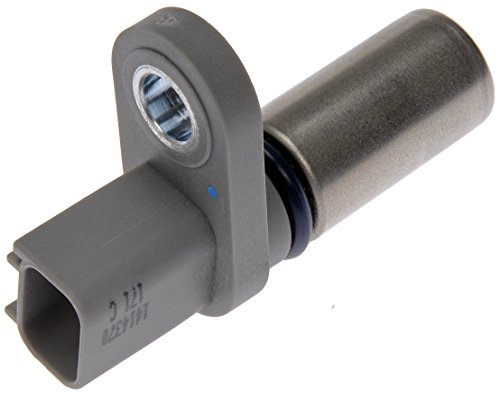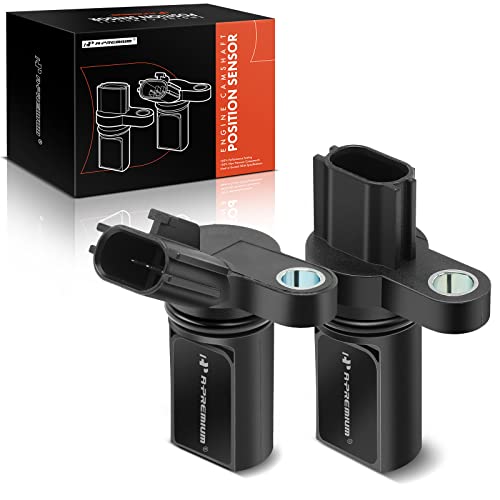5 Top Camshaft Position Sensor CMP Reviews: Keep Your Engine Running Smoothly
Has your trusty vehicle been acting a bit off lately? Maybe the “Check Engine” light decided to make an unwelcome appearance, or you’ve noticed some rough idling, misfires, or even trouble starting? These could all be tell-tale signs that your camshaft position sensor CMP is on its way out. This tiny but mighty automotive sensor plays a critical role in your engine’s performance, helping the vehicle’s computer (ECU) know exactly where the camshaft is rotating. When it fails, your engine timing goes awry, leading to all sorts of headaches.
Don’t fret! Replacing a faulty camshaft position sensor doesn’t have to be a daunting task, and finding a quality replacement is key. We’ve scoured the market to bring you a list of top-notch options to get your ride back in prime condition. Let’s dive in!
What Does a Camshaft Position Sensor Do, Anyway?
Before we jump into the reviews, let’s quickly understand why this sensor is so important. The camshaft position sensor (often abbreviated as CMP sensor) works by monitoring the speed and position of your engine’s camshaft. This data is then sent to the Engine Control Unit (ECU), which uses it to precisely control critical engine functions like fuel injection timing and ignition timing. It works in conjunction with the crankshaft position sensor to provide a complete picture of your engine’s rotation. Without accurate data from your CMP sensor, your car’s computer can’t efficiently manage these processes, leading to the performance issues we mentioned.
How to Know When Your Camshaft Position Sensor is Failing?
Symptoms of a bad camshaft position sensor can vary, but here are some common indicators:
* Check Engine Light (CEL) Illumination: This is often the first sign, usually accompanied by specific diagnostic trouble codes (DTCs) like P0340.
* Engine Misfires or Rough Idling: Inaccurate timing can cause cylinders to fire incorrectly.
* Difficulty Starting: The ECU might struggle to determine the correct timing for starting the engine.
* Sudden Stalling: The engine might suddenly shut off, especially when coming to a stop.
* Decreased Fuel Economy: Inefficient timing can lead to more fuel consumption.
* Poor Acceleration or Hesitation: Your engine might not respond as expected when you press the gas pedal.
If you’re experiencing any of these, it’s a good idea to have your camshaft position sensor cmp checked out. Now, let’s look at some excellent replacement options.
1. A-Premium Camshaft Position Sensor Left & Right

This A-Premium two-pack is a fantastic option for owners of compatible Infiniti and Nissan V6 vehicles, offering both left and right camshaft position sensors in one convenient package. This means you’re covered for both banks of your engine, simplifying the purchase and ensuring you have the right parts for a complete replacement. It’s built to meet or exceed OEM specifications, giving you peace of mind that you’re installing reliable components designed for a direct fit.
Key Features:
– Compatible with a wide range of Infiniti (FX35, G35, I35, M35) and Nissan (350Z, Altima, Maxima, Murano, Quest, Frontier, NV series, Pathfinder, Xterra) V6 models.
– Includes two sensors (Bank 1 and Bank 2) for a comprehensive solution.
– Direct replacement for various OEM part numbers, ensuring accurate fitment.
– Features 3-pin blade terminals for secure connections.
– Comes with a one-year unlimited-mileage guarantee for buyer confidence.
Pros:
– Comprehensive solution with two sensors included.
– Wide vehicle compatibility across popular Nissan and Infiniti V6 models.
– Meets OEM specifications for reliable performance.
– Excellent warranty coverage provides peace of mind.
– Good value for money compared to buying separate sensors.
Cons:
– Specific to Nissan/Infiniti V6 3.5L/4.0L engines, so check fitment carefully.
– May require professional installation for those less experienced.
User Impressions:
Users often praise this A-Premium set for its perfect fit and effectiveness in resolving their engine issues, particularly the dreaded check engine light. Many appreciate getting both sensors, especially for vehicles where both might eventually fail, making it a convenient and economical choice. The quality and direct replacement nature are frequently highlighted.
Call to Action:
See it on Amazon here
2. ACDelco Professional 213-4664 Engine Camshaft Position

When it comes to automotive components, ACDelco is a name synonymous with reliability, often trusted as an OEM (Original Equipment Manufacturer) supplier. The ACDelco Professional 213-4664 engine camshaft position sensor lives up to this reputation, offering a premium aftermarket replacement designed to provide the performance and dependability you’d expect from original factory parts. If you value brand trust and consistent quality, this is a strong contender.
Key Features:
– Professional-grade, premium aftermarket replacement part.
– Engineered to deliver performance and dependability comparable to OEM.
– Manufactured to meet high expectations for fit, form, and function.
– Backed by the trusted ACDelco brand.
Pros:
– Excellent brand reputation for quality and reliability.
– Designed to meet OEM standards for fit and performance.
– Provides consistent and accurate readings to the ECU.
– A dependable choice for a variety of GM vehicles (ensure specific fitment check).
Cons:
– May be a bit pricier than some generic aftermarket alternatives.
– Specific vehicle fitment needs to be verified carefully (ACDelco primarily serves GM vehicles, though “Professional” line may extend).
User Impressions:
Customers who opt for ACDelco often do so for its proven track record. They typically report that the sensor fits perfectly and resolves their issues, with many noting that it performs just like the original part. The longevity and consistent function are frequently cited as reasons for satisfaction.
Call to Action:
See it on Amazon here
3. Dorman 907-760 Engine Crankshaft Position Sensor Compatible

Important Note: While our main focus is on the camshaft position sensor, this Dorman product is specifically an engine crankshaft position sensor. It’s a related, but distinct, component in your engine’s timing system. However, Dorman is a highly respected brand for automotive aftermarket parts, known for providing direct replacement solutions that address common failure points. This sensor is engineered to ensure your engine control unit receives accurate inputs from the crankshaft, which is crucial for overall engine timing and performance, just like the camshaft position sensor CMP.
Key Features:
– Direct replacement designed to match the fit and function of an original crankshaft sensor.
– Engineered to ensure proper inputs to the engine control unit.
– Durable construction designed to strict specifications for reliable performance.
– Backed by Dorman, a company with over a century of automotive experience.
– Vehicle fitment can be confirmed via their garage tool for accuracy.
Pros:
– Dorman’s reputation for quality aftermarket parts.
– Direct-fit design simplifies installation.
– Robust construction for long-lasting reliability.
– Helps resolve common crankshaft sensor-related issues like stalling or hard starting.
Cons:
– This is a crankshaft position sensor, not a camshaft position sensor.
– Vehicle fitment must be carefully checked using Dorman’s specific lookup tool.
User Impressions:
Dorman products are often chosen for their accessibility and direct replacement nature. Users frequently praise this crankshaft sensor for resolving their vehicle’s issues, especially intermittent stalling or no-start conditions related to a faulty crankshaft sensor. The ease of installation due to its direct fit is also a common positive remark.
Call to Action:
See it on Amazon here
4. A-NAFTULY Camshaft Position Sensor Compatible with Hyundai

For Hyundai and Kia owners facing issues with their camshaft position sensor, the A-NAFTULY replacement offers a dedicated solution. This sensor is specifically designed to be a direct replacement for particular Hyundai and Kia models, ensuring a precise fit and reliable function. It addresses common problems like hard starting, engine misfires, and uneven acceleration, helping to restore your vehicle’s smooth operation.
Key Features:
– Specific vehicle fitment for Hyundai Santa Fe (2013-2018), Azera (2012-2017), Genesis (2012-2014), Genesis Coupe (2012-2016), and Kia Sedona (2015-2018), Sorento (2014-2016), Cadenza (2014-2016).
– Direct replacement for OEM part numbers like PC946 and 393183C500.
– Functions to measure camshaft rotation and position for the ECU.
– Plug-and-play installation method for easy replacement.
– Includes an 18-month worry-free warranty.
Pros:
– Highly specific fitment ensures compatibility for listed Hyundai/Kia models.
– Direct replacement design for straightforward installation.
– Helps resolve common symptoms of a failing cam sensor.
– Generous 18-month warranty offers extended peace of mind.
– Affordable and effective solution.
Cons:
– Limited to specific Hyundai and Kia models, not a universal fit.
– Some users might prefer more established brand names.
User Impressions:
Customers with compatible Hyundai and Kia vehicles have reported positive experiences, noting that this sensor effectively eliminates their check engine light codes and resolves performance issues. The direct fit and ease of installation are frequently mentioned, along with appreciation for the included warranty.
Call to Action:
See it on Amazon here
5. A-Premium Engine Camshaft Position Sensor Compatible with

Another strong offering from A-Premium, this single camshaft position sensor is designed to cover an incredibly broad range of Chrysler, Dodge, Jeep, Ram, and Volkswagen vehicles, particularly those with the popular 3.6L Pentastar engine. If you drive one of these American or German (via platform sharing) workhorses and suspect your camshaft position sensor is failing, this could be your go-to. It’s built for direct replacement and reliability across many model years.
Key Features:
– Extensive vehicle fitment covering Chrysler (200, 300, Town & Country), Dodge (Avenger, Challenger, Charger, Durango, Grand Caravan, Journey), Jeep (Cherokee, Grand Cherokee, Wrangler), Ram (1500, C/V, ProMaster series), and Volkswagen Routan.
– Direct replacement for various OEM part numbers like 5149141AF and PC950.
– Features 4-pin blade terminals for secure connection.
– Single sensor package.
– Comes with a one-year unlimited-mileage guarantee.
Pros:
– Extremely wide compatibility with popular Chrysler, Dodge, Jeep, Ram, and VW models.
– Direct fit and easy installation for most DIYers.
– Reliable performance backed by A-Premium’s quality standards.
– Solid one-year warranty for assurance.
Cons:
– Make sure to verify the specific sensor location (if your vehicle uses multiple).
– While broad, always double-check your exact make/model/engine.
User Impressions:
Owners of compatible vehicles frequently commend this A-Premium camshaft position sensor for its perfect fit and effectiveness. Many report that it quickly resolves their check engine light and restores smooth engine operation. The broad compatibility is a big plus for mechanics and multi-vehicle households.
Call to Action:
See it on Amazon here
Frequently Asked Questions (FAQ)
Q1: What are the common symptoms of a bad camshaft position sensor?
A1: The most common symptoms include your Check Engine Light illuminating, engine misfires, rough idling, difficulty starting, sudden engine stalling, and sometimes decreased fuel economy or poor acceleration. Your vehicle’s diagnostic system might also show specific codes like P0340.
Q2: Can I drive with a bad camshaft position sensor?
A2: While you might be able to drive a short distance, it’s not recommended. A faulty camshaft position sensor can lead to unreliable engine performance, unpredictable stalling, and potentially cause further damage to other engine components due to incorrect timing. It’s best to replace it as soon as possible.
Q3: Is a camshaft position sensor hard to replace?
A3: The difficulty level varies greatly depending on your vehicle’s make and model. Some camshaft position sensors are easily accessible, making it a relatively simple DIY job, while others are tucked away in harder-to-reach locations requiring more tools and expertise. Always consult your vehicle’s service manual or a professional mechanic.
Q4: What’s the difference between a camshaft position sensor and a crankshaft position sensor?
A4: Both are vital for engine timing. The camshaft position sensor (CMP) monitors the position of the camshaft, which controls valve opening and closing. The crankshaft position sensor (CKP) monitors the position and speed of the crankshaft, which drives the pistons. Together, they give the ECU the precise information needed to time fuel injection and spark delivery. While related, they perform distinct functions and are typically not interchangeable.
Q5: How much does it cost to replace a camshaft position sensor?
A5: The cost of the part itself can range from $20 to $100+, depending on your vehicle and whether you choose an OEM or aftermarket sensor. If you have it professionally replaced, labor costs can add another $50 to $200+, depending on the accessibility of the sensor and shop rates.
Q6: Can a bad camshaft position sensor cause my car to misfire?
A6: Yes, absolutely. If the camshaft position sensor provides inaccurate data or no data at all to the ECU, the engine’s timing (for both fuel injection and ignition) can be thrown off. This can lead to cylinders firing at the wrong time, resulting in noticeable engine misfires.
Q7: Does a camshaft position sensor affect fuel economy?
A7: Yes, indirectly. When the camshaft position sensor is faulty, the engine’s timing becomes less precise. This inefficiency can lead to the engine consuming more fuel than necessary to achieve the desired performance, resulting in decreased fuel economy.







